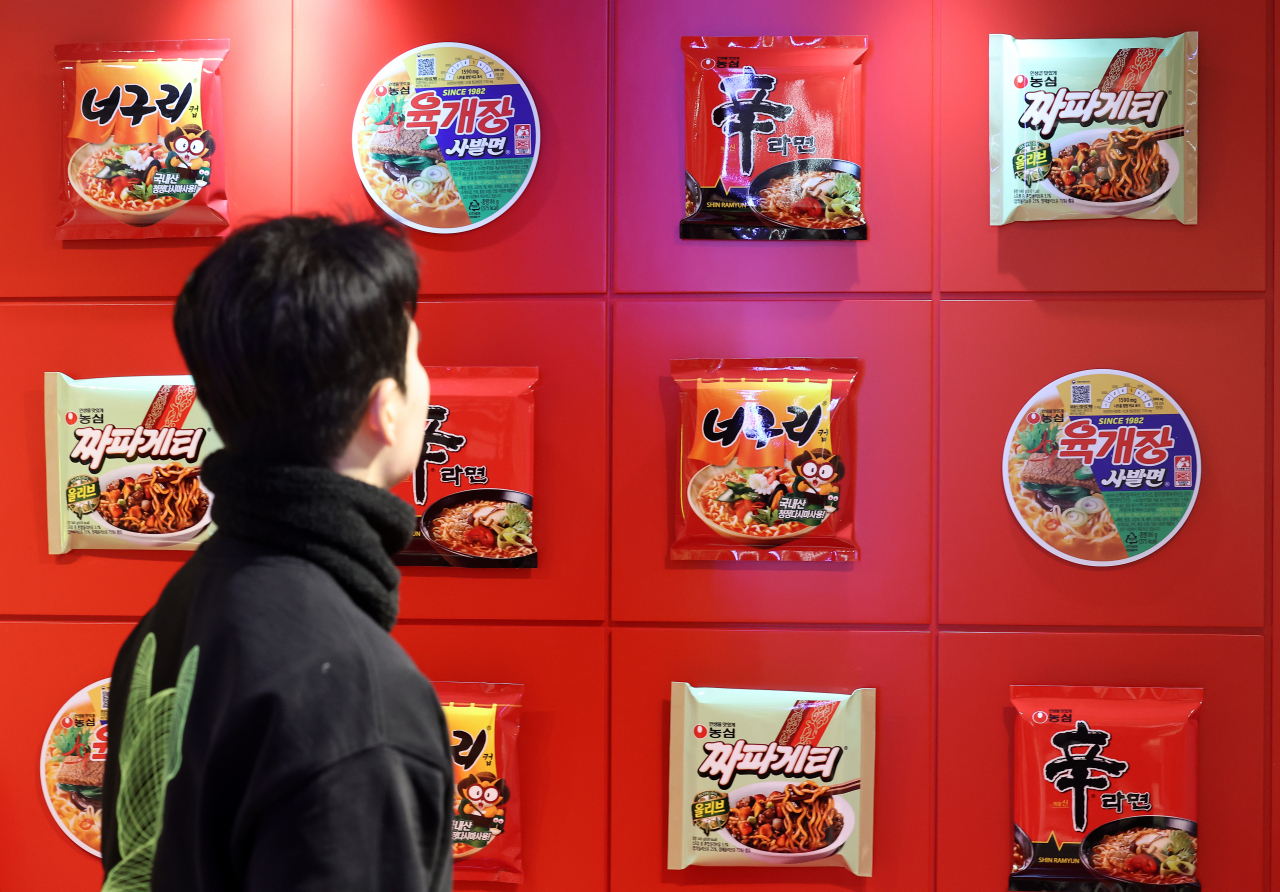 |
Nongshim, the nation’s largest ramyeon maker, operates a brand zone at a shopping mall in Myeong-dong, central Seoul, Jan. 31. (Newsis) |
Amid soaring exports of Korean instant noodles in recent years, a renewed spotlight has been cast on a decadeslong dilemma among local food companies -- whether or not the word "ramen" should be ditched from their marketing strategy.
Ramen, rooted in Japanese culinary tradition, has become a household name globally that refers to noodles in broth. The term "ramen" can also refer to instant noodle products.
Amid a growing global presence, Korean businesses have long used the term in overseas markets, introducing their own instant products as "Korean ramen,” instead of as “ramyeon,” the Korean variation of the word.
Using the Japanese word is viewed as taboo in Korea, akin to referring to kimchi as "kimuchi," the Japanese phonetic interpretation of the word.
Adding to the confusion, Nongshim, the nation’s top ramyeon seller, Romanizes the word as “ramyun” for its products sold overseas.
“We are trying to use ‘ramyeon’ for overseas marketing if possible. But without an industry-wide consensus, our efforts have a limited impact,” said an official from a local food company who wished to remain unnamed. The official added that his company’s current product packaging uses “ramen” because they are still in the early stages of overseas expansion.
However, experts agree that referring to ramyeon as “ramen” is technically inaccurate from a historical and culinary perspective.
Linguistic, historical origin
Yoon Seok-jin, a professor of Korean language and literature at Chungnam National University, said that "ramen" may be more accurately described as a marketing term rather than a standard noun.
According to Yoon, ramen has its origin in China’s hand-pulled noodles, called “lamian.” Lamian was introduced to Japan in the late 19th or early 20th century and evolved into ramen, using regional flavors and ingredients. The post-World War II era saw a surge in the popularity of instant ramen, which quickly became a Japanese culinary staple.
When it comes to Korea’s ramyeon, Yoon noted that local food company Samyang debuted the nation’s first instant noodle product in 1963, possibly by taking a cue from Japan. Ramyeon continued to grow to become an integral part of Korean food culture with its convenience and distinct, spicy flavor.
“Ramen is a term that was coined in Japan to denote a particular type of noodle dish. Likewise, ramyeon represents the Korean instant noodle adaptation of this concept today,” Yoon said. “Ramen and ramyeon should be recognized as two different foods that have continued evolving to reflect different local tastes.”
Yoon compared the need for distinct terms to the use of different names for rice rolls wrapped in dried seaweed, referred to as maki in Japanese and gimbap in Korean.
Culinary differences
Traditionally, Japanese ramen is made with wheat noodles served in a rich broth, which can be made with chicken, pork, seafood, or vegetables. The broth is often seasoned with soy sauce or miso, and the dish is topped with ingredients like sliced pork, green onions, seaweed and bamboo shoots.
Japanese ramen also comes in instant, packaged forms with seasoning packets and dehydrated vegetables, although the flavor profile differs from ramyeon. The flavor of ramen, both instant and traditional, is more savory, thanks to a soy sauce or bone-based broth. The diversity in ramen's flavor profiles reflects the regional preferences across Japan.
Korean ramyeon refers exclusively to instant noodle products, where the noodles are also made from wheat, but are generally thinner. The flavor of ramyeon is characteristically spicy and often includes a seasoning packet with chili, garlic and dehydrated vegetable flakes. Ramyeon can be enjoyed on its own or with added ingredients like egg and cheese to enhance the flavor.
Restaurants in Korea do sell ramyeon, but the base will always originate from an instant package. So, when you order a bowl of ramyeon at a Korean restaurant, chefs will create variations by adding fresh ingredients.
"Ramyeon is renowned for its fiery and robust flavors, characterized by a spicy kick, whereas Japan's ramen highlights the making of the broth. Culinary-wise, it is a very different concept," said an owner-chef at a Korean restaurant in Seoul who wished to be unnamed.
Consumer dynamics
Korean ramyeon makers do not doubt that their products are different from Japan’s ramen but they seem reluctant to remove the term from their product packages due to consumer awareness and marketing strategy.
“Our management has also started discussing the issue more recently,” said an official of a ramyeon company on condition of anonymity. “Changing the product name would be a strategic decision rather than a matter of costs.”
A Nongshim official was skeptical about a possible name change. “Nongshim pioneered the use of ‘ramyun’ over ramen. Our brand name, Shin Ramyun, has already secured a firm footing among global consumers. It is extremely difficult for us to change the spelling quickly.”
Lee Eun-hee, a professor at Inha University's Department of Consumer Science, underscored the evolving cultural dynamics in Korea that may have been influencing the terminology shift. Lee noted that standardizing Romanization not only taps into burgeoning K-culture trends but also guards against the misleading of consumers through the use of words that refer to two different things.
Lee said that it is understandable for ramyeon companies in Korea to have used the term "ramen" in the past for exports, since it is more widely recognized and easy to understand for consumers abroad.
"But, just as culinary glossaries adapt to changing usages and evolving needs, consistent and unified use of the term 'ramyeon' can gradually establish the unique value and characteristics of Korean ramyeon," Lee said.







